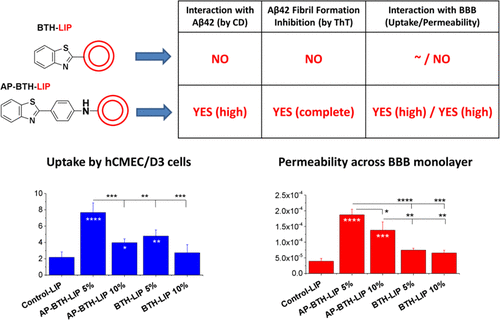当前位置:
X-MOL 学术
›
Biomacromolecules
›
论文详情
Our official English website, www.x-mol.net, welcomes your
feedback! (Note: you will need to create a separate account there.)
Liposomes Decorated with 2-(4′-Aminophenyl)benzothiazole Effectively Inhibit Aβ1–42 Fibril Formation and Exhibit in Vitro Brain-Targeting Potential
Biomacromolecules ( IF 5.5 ) Pub Date : 2020-10-28 , DOI: 10.1021/acs.biomac.0c00811 Spyridon Mourtas 1, 2 , Barbara Mavroidi 3 , Antonia Marazioti 1, 2 , Maria Kannavou 1, 2 , Marina Sagnou 3 , Maria Pelecanou 3 , Sophia G Antimisiaris 1, 2
Biomacromolecules ( IF 5.5 ) Pub Date : 2020-10-28 , DOI: 10.1021/acs.biomac.0c00811 Spyridon Mourtas 1, 2 , Barbara Mavroidi 3 , Antonia Marazioti 1, 2 , Maria Kannavou 1, 2 , Marina Sagnou 3 , Maria Pelecanou 3 , Sophia G Antimisiaris 1, 2
Affiliation

|
The potential of 2-benzothiazolyl-decorated liposomes as theragnostic systems for Alzheimer’s disease was evaluated in vitro, using PEGylated liposomes that were decorated with two types of 2-benzothiazoles: (i) the unsubstituted 2-benzothiazole (BTH) and (ii) the 2-(4-aminophenyl)benzothiazole (AP-BTH). The lipid derivatives of both BTH-lipid and AP-BTH-lipid were synthesized, for insertion in liposome membranes. Liposomes (LIP) containing three different concentrations of benzothiazoles (5, 10, and 20%) were formulated, and their stability, integrity in the presence of serum proteins, and their ability to inhibit β-amyloid (1–42) (Αβ42) peptide aggregation (by circular dichroism (CD) and thioflavin T (ThT) assay), were evaluated. Additionally, the interaction of some LIP with an in vitro model of the blood–brain barrier (BBB) was studied. All liposome types ranged between 92 and 105 nm, with the exception of the 20% AP-BTH-LIP that were larger (180 nm). The 5 and 10% AP-BTH-LIP were stable when stored at 4 °C for 40 days and demonstrated high integrity in the presence of serum proteins for 7 days at 37 °C. Interestingly, CD experiments revealed that the AP-BTH-LIP substantially interacted with Αβ42 peptides and inhibited fibril formation, as verified by ThT assay, in contrast with the BTH-LIP, which had no effect. The 5 and 10% AP-BTH-LIP were the most effective in inhibiting Αβ42 fibril formation. Surprisingly, the AP-BTH-LIP, especially the 5% ones, demonstrated high interaction with brain endothelial cells and high capability to be transported across the BBB model. Taken together, the current results reveal that the 5% AP-BTH-LIP are of high interest as novel targeted theragnostic systems against AD, justifying further in vitro and in vivo exploitation.
中文翻译:

装饰有 2-(4'-氨基苯基)苯并噻唑的脂质体可有效抑制 Aβ1-42 原纤维的形成并表现出体外脑靶向潜力
在体外评估了 2-苯并噻唑修饰的脂质体作为阿尔茨海默病治疗系统的潜力,使用修饰有两种 2-苯并噻唑的聚乙二醇化脂质体:(i) 未取代的 2-苯并噻唑 (BTH) 和 (ii) 2-(4-氨基苯基)苯并噻唑(AP-BTH)。合成了 BTH-lipid 和 AP-BTH-lipid 的脂质衍生物,用于插入脂质体膜。配制了含有三种不同浓度苯并噻唑(5%、10% 和 20%)的脂质体 (LIP),以及它们在血清蛋白存在下的稳定性、完整性以及它们抑制 β-淀粉样蛋白 (1-42) (Aβ42) 的能力肽聚集(通过圆二色性(CD)和硫代黄素T(ThT)测定)进行了评估。此外,还研究了一些 LIP 与血脑屏障 (BBB) 体外模型的相互作用。所有脂质体类型的范围在 92 和 105 nm 之间,除了较大的 20% AP-BTH-LIP (180 nm)。5% 和 10% AP-BTH-LIP 在 4 °C 下储存 40 天时是稳定的,并且在血清蛋白存在下在 37 °C 下保存 7 天时表现出高度完整性。有趣的是,CD 实验显示 AP-BTH-LIP 与 Aβ42 肽显着相互作用并抑制原纤维形成,如通过 ThT 测定所证实的,与没有效果的 BTH-LIP 形成对比。5% 和 10% AP-BTH-LIP 在抑制 Aβ42 原纤维形成方面最有效。令人惊讶的是,AP-BTH-LIP,尤其是 5% 的,表现出与脑内皮细胞的高度相互作用和通过 BBB 模型运输的高能力。综合起来,
更新日期:2020-12-14
中文翻译:

装饰有 2-(4'-氨基苯基)苯并噻唑的脂质体可有效抑制 Aβ1-42 原纤维的形成并表现出体外脑靶向潜力
在体外评估了 2-苯并噻唑修饰的脂质体作为阿尔茨海默病治疗系统的潜力,使用修饰有两种 2-苯并噻唑的聚乙二醇化脂质体:(i) 未取代的 2-苯并噻唑 (BTH) 和 (ii) 2-(4-氨基苯基)苯并噻唑(AP-BTH)。合成了 BTH-lipid 和 AP-BTH-lipid 的脂质衍生物,用于插入脂质体膜。配制了含有三种不同浓度苯并噻唑(5%、10% 和 20%)的脂质体 (LIP),以及它们在血清蛋白存在下的稳定性、完整性以及它们抑制 β-淀粉样蛋白 (1-42) (Aβ42) 的能力肽聚集(通过圆二色性(CD)和硫代黄素T(ThT)测定)进行了评估。此外,还研究了一些 LIP 与血脑屏障 (BBB) 体外模型的相互作用。所有脂质体类型的范围在 92 和 105 nm 之间,除了较大的 20% AP-BTH-LIP (180 nm)。5% 和 10% AP-BTH-LIP 在 4 °C 下储存 40 天时是稳定的,并且在血清蛋白存在下在 37 °C 下保存 7 天时表现出高度完整性。有趣的是,CD 实验显示 AP-BTH-LIP 与 Aβ42 肽显着相互作用并抑制原纤维形成,如通过 ThT 测定所证实的,与没有效果的 BTH-LIP 形成对比。5% 和 10% AP-BTH-LIP 在抑制 Aβ42 原纤维形成方面最有效。令人惊讶的是,AP-BTH-LIP,尤其是 5% 的,表现出与脑内皮细胞的高度相互作用和通过 BBB 模型运输的高能力。综合起来,











































 京公网安备 11010802027423号
京公网安备 11010802027423号